|
|
|
Sort Order |
|
|
|
Items / Page
|
|
|
|
|
|
|
| Srl | Item |
| 1 |
ID:
182732
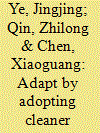

|
|
|
|
|
| Summary/Abstract |
We study how a low-emission zone (LEZ) policy affects air pollution in Nanchang, a medium-sized city located in southeastern China. By using a regression discontinuity design approach, we find that the LEZ policy improves Nanchang's air quality throughout restricted/unrestricted hours and within/outside of the designated LEZ areas. Air quality began to improve during the announcement period and improved further after the policy was enforced. These findings suggest that drivers could adapt to the foreseen LEZ policy by upgrading their vehicles; thus, to achieve policy effectiveness, it is important to make driving regulations compatible with drivers' incentives.
|
|
|
|
|
|
|
|
|
|
|
|
|
|
|
|
| 2 |
ID:
168324
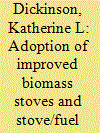

|
|
|
|
|
| Summary/Abstract |
In order to support transitions away from open-fire cooking and toward cleaner household energy systems, a better understanding of users’ technology adoption patterns and preferences is needed. This paper highlights key factors influencing use of two types of biomass-burning stoves provided through the REACCTING (Research on Emissions, Air quality, Climate, and Cooking Technology in Northern Ghana) randomized intervention study. We examine traditional and improved stove use over a two year follow up period, finding that the more basic rocket stove was used at a higher rate than the higher-tech gasifier stove. While stove use patterns varied by stove group, region, primary cook occupation, and socioeconomic status, use of traditional stoves remained high across most groups. Users perceived that improved stoves were less suitable for cooking a staple dish, Tuo Zaafi (TZ), and technical problems (e.g., battery failures with the gasifier stove) also limited the effectiveness of the intervention. Moving forward, household energy policies should prioritize a range of technologies that have potential to meet local needs while delivering meaningful health and/or environmental benefits, recognizing that stove and fuel “stacking” is likely to persist. A greater focus on markets and enabling environments is needed to support sustainable and scalable energy transitions.
|
|
|
|
|
|
|
|
|
|
|
|
|
|
|
|
| 3 |
ID:
182761
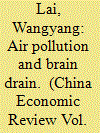

|
|
|
|
|
| Summary/Abstract |
This paper provides one of the few evidence about migration responses among talents to air pollution. Specifically, we investigate the impact of PM2.5 concentration on job location decisions of Chinese college graduates at the beginning of their professional careers. The results indicate that a 10-unit increase in PM2.5 concentration raises college graduates' probability to leave their current city by 10% point. We also find larger impacts on graduates from elite colleges and less polluted hometowns. Our empirical results are consistent with a simple model in which the location choice of college graduates depends on their wage payment and air pollution. Our findings supplement existent literature in documenting important ways in which air pollution may associate with the loss of highly-educated talents.
|
|
|
|
|
|
|
|
|
|
|
|
|
|
|
|
| 4 |
ID:
159836
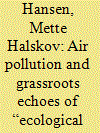

|
|
|
|
|
| Summary/Abstract |
This article places the study of rural environmental activism in the wider context of the Chinese government's promotion of Ecological Civilization (shengtai wenming 生态文明). Ecological Civilization is, we argue, a top-down imaginary of China's future that opens up space for environmental agency while setting authoritative standards for how to frame protests in a logic of science and social stability. The article compares how residents in a small cluster of villages in Zhejiang province dealt with different sources of air pollution over a span of ten years: how, when and why they chose to negotiate with local officials and industrial managers to prevent or reduce air pollution, and what the outcome was. We found that in addition to a consciousness of the right to protest, villagers had come to regard the ability to evoke science in negotiations with officials and industrial managers as crucial for success. We suggest that the forms of environmental activism we observed were in effect “containable protests” that befit the state-initiated national imaginary of an ecologically civilized world.
|
|
|
|
|
|
|
|
|
|
|
|
|
|
|
|
| 5 |
ID:
182769
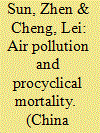

|
|
|
|
|
| Summary/Abstract |
There is growing evidence that in developed countries, mortality rises (falls) in economic booms (busts). However, little is known about the cyclical pattern of mortality in developing countries. Using China's city-year data, we find that the total mortality in China also exhibits procyclical fluctuations. In exploring the mechanisms, we find that air pollution is one of the reasons for procyclical fluctuations in total mortality. Specifically, economic booms lead to severe air pollution, worsening human health and thus increasing death rates. Moreover, we find that changes in lifestyles may not be an important reason for procyclical mortality in China.
|
|
|
|
|
|
|
|
|
|
|
|
|
|
|
|
| 6 |
ID:
014143
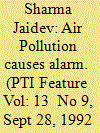

|
|
|
|
|
| Publication |
Sept 28, 1992.
|
| Description |
pf-F147
|
|
|
|
|
|
|
|
|
|
|
|
|
|
|
|
| 7 |
ID:
150829
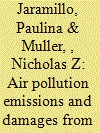

|
|
|
|
|
| Summary/Abstract |
This paper uses air pollution emissions data for the years 2002, 2005, 2008, and 2011 to estimate monetary damages due to air pollution exposure for PM2.5, SO2, NOx, NH3, and VOC from electric power generation, oil and gas extraction, coal mining, and oil refineries. In 2011, damages associated with emissions from these sectors totaled 131 billion dollars (in 2000$), with SO2 emissions from power generation being the largest contributors to social damages. Further, damages have decreased significantly since 2002, even as energy production increased, suggesting that, among other factors, policies that have driven reductions in emissions have reduced damages. The results of this analysis highlight the spatial heterogeneity of the impacts associated with the emissions of a given pollutant. In the past, environmental regulations have assumed that the benefits of air emissions reductions are homogenous across source location. This analysis suggests that policy designs that account for spatial differences in the impacts of air emissions could result in more effective environmental regulation. Accounting for such spatial heterogeneity in the benefits of policies would be akin to accounting for differences in compliances costs across states, which the EPA did when establishing the state emissions standards for the Clean Power Plan rule.
|
|
|
|
|
|
|
|
|
|
|
|
|
|
|
|
| 8 |
ID:
150774
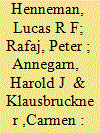

|
|
|
|
|
| Summary/Abstract |
Affordable energy supply and reductions in emissions of local air pollution and greenhouse gases are each important aspects of South Africa's goals. Many traditional solutions, however, work in contradiction to one another. This work investigates effects on estimated emissions and costs of mitigation strategies using the Greenhouse Gas and Air Pollution Interaction Synergies (GAINS) model to identify policies that satisfy multiple goals. Eight scenarios that describe air pollution control options and mixes of energy production technologies are implemented in GAINS, which quantifies country-wide air pollution and greenhouse emissions and costs of controls. Emissions and costs trajectories are compared to the business as usual case, which projects CO2 emissions to increase by 60% by 2050 compared to 2015. Results show that replacing all coal generation with renewables reduces CO2 emissions in 2050 by 8% compared to 2015, and that aggressive policy targeting the whole energy sector reduces CO2 emissions in 2050 by 40%. GAINS is used to show co-benefits and tradeoffs of each scenario, such as reductions in emissions control costs that accompany a switch to renewables. The approach provides supporting evidence for policies that exploit co-benefits and avoid contradictions by assessing multiple aspects of the energy sector within the integrated framework provided by the GAINS modeling platform.
|
|
|
|
|
|
|
|
|
|
|
|
|
|
|
|
| 9 |
ID:
166966
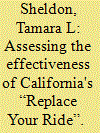

|
|
|
|
|
| Summary/Abstract |
We analyze the effectiveness of California's “Replace Your Ride” policy, a pilot program that gives subsidies to lower income households in the greater Los Angeles area to retire older vehicles and replace them with newer, cleaner vehicles. Using a differences in differences strategy to compare changes in new vehicle purchase probabilities between income eligible and ineligible households before and after the implementation of the program, we find that in 2015, upwards of 44% of plug-in electric vehicle and 78% of hybrid vehicle purchases under the program were additional.
|
|
|
|
|
|
|
|
|
|
|
|
|
|
|
|
| 10 |
ID:
093523
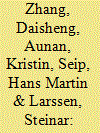

|
|
|
|
|
| Publication |
2010.
|
| Summary/Abstract |
We establish the link between energy use, air pollution, and public health impacts in Taiyuan for 2000, and for 2010 and 2015 under alternative scenarios. We find that in year 2000 more than 2200 excess deaths may have been caused by particulate matter (PM) pollution. Using alternative methods for monetization of health impacts the total health damage amounts to 0.8-1.7 billion Yuan, which is 2.4-4.9% of the city's GDP in 2000. Compared to the business-as-usual scenario, scenarios assuming extensive fuel switch in low-and-medium-stack pollution sources and extension of the district heating system could prevent 200-1100 PM10-related premature deaths in 2010 and substantially reduce population morbidity. The actual PM pollution in 2007 was lower than modeled in these two scenarios. We also find that if air quality in urban Taiyuan were to reach the Chinese National Grade II Standard in 2015, the number of premature deaths would still be around 1330 and the economic cost about 1-2% of the city's GDP in 2015. Our results imply that there are large health benefits to be gained by setting stricter standards for the future in China, and that targeting low-and-medium-stack source effectively reduces health damage.
|
|
|
|
|
|
|
|
|
|
|
|
|
|
|
|
| 11 |
ID:
091526
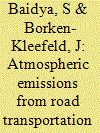

|
|
|
|
|
| Publication |
2009.
|
| Summary/Abstract |
India has become one of the biggest emitters of atmospheric pollutants from the road transportation sector globally. Here we present an up-to-date inventory of the exhaust emissions of ten species. This inventory has been calculated bottom-up from the vehicle mileage, differentiating by seven vehicle categories, four age/technology layers and three fuel types each, for the seven biggest cities as well as for the whole nation. The age composition of the rolling fleet has been carefully modelled, deducting about one quarter of vehicles still registered but actually out-of-service. The vehicle mileage is calibrated to the national fuel consumption which is essential to limit uncertainties. Sensitivity analyses reveal the primary impact of the emission factors and the secondary influence of vehicle mileage and stock composition on total emissions. Emission estimates since 1980 are reviewed and qualified. A more comprehensive inspection and maintenance is essential to limit pollutant emissions; this must properly include commercial vehicles. They are also the most important vehicle category to address when fuel consumption and CO2 emissions shall be contained.
|
|
|
|
|
|
|
|
|
|
|
|
|
|
|
|
| 12 |
ID:
156449
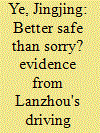

|
|
|
|
|
| Summary/Abstract |
Driving restriction policies (DRPs) have been adopted worldwide to curb traffic congestion and air pollution. However, the empirical evidence of the effectiveness of such policies in improving air quality remains mixed (e.g., Davis, 2008; Viard & Fu, 2015). Individuals may change their commute schedules/routes or hire/purchase additional vehicles to circumvent such restrictions. This paper addresses this possibility by utilizing hourly measurements of air pollutants from monitoring stations at Lanzhou, one of the most polluted cities in China. Utilizing a regression discontinuity design (RD) approach, we concluded that the driving restrictions in Lanzhou are ineffective in improving its air quality. Specific hour and location results suggest that drivers shift their travel schedules, take detours, and acquire alternative vehicles. The results are robust after considering alternative model specifications and sample restrictions.
|
|
|
|
|
|
|
|
|
|
|
|
|
|
|
|
| 13 |
ID:
136210
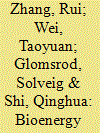

|
|
|
|
|
| Summary/Abstract |
Biomass in the form of crop residues and firewood is a major energy source for rural households in China. A survey conducted in the provinces of Shanxi, Zhejiang, and Guizhou shows that 37 percent of rural households use bioenergy for heating and cooking and that bioenergy accounts for 18 percent of their total energy consumption. Most of the biomass used for energy is burned in traditional stoves, contributing to indoor air pollution in rural homes. Crop residues also are commonly burned in the fields, contributing to the high level of outdoor air pollution in China. Our econometric analysis of the key determinants of bioenergy use shows that bioenergy consumption falls modestly with income growth, increased time required for biomass collection, and less farmland. Hence, open burning of some biomass is an optimal choice and is likely to become more of a problem without policy intervention. These findings suggest that a more sustainable use of biomass requires policies that promote cleaner, more efficient bioenergy combustion technologies and increase the economic value of biomass such that local households can benefit from biomass collection.
|
|
|
|
|
|
|
|
|
|
|
|
|
|
|
|
| 14 |
ID:
155667
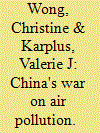

|
|
|
|
|
| Summary/Abstract |
Unprecedented and highly visible degraded air quality in China's urban centres has prompted a step change in central government control efforts in recent years. This “War on Air Pollution” has included a mixture of administrative controls, regulatory clampdowns, economic incentives and public education campaigns. A critical constraint on how policies are designed and implemented is the central government's capacity to access accurate cost information, and monitor, evaluate and enforce the policies at subordinate levels of government. We examine in detail the directives and arrangements that underpin China's “War on Air Pollution” at the provincial level, taking Hebei province as a case study. Located upwind of Beijing, Hebei's heavy industries have been a particular focus of the environmental policies. The current approach, which requires highly specific and costly local actions, yet allocates funds centrally, suffers from misaligned incentives and does not address longstanding weaknesses in local policy monitoring, evaluation and enforcement.
|
|
|
|
|
|
|
|
|
|
|
|
|
|
|
|
| 15 |
ID:
192847
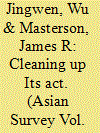

|
|
|
|
|
| Summary/Abstract |
The urgent and global concern of environmental problems transcends local and regional boundaries, posing significant challenges for policymakers in developing countries. Amid conflicting economic and environmental goals, evaluating the efficacy of regulatory policies becomes increasingly critical. This study investigates the effectiveness of public policy in incentivizing developing nations to prioritize environmental regulation, with a specific focus on China’s most recent environmental policy, the Ecological Environmental Protection Plan. Using multilevel modeling and difference-in-differences estimation with data from six of China’s most populous cities between 2014 and 2019, we see evidence of air quality improvements following the implementation of the policy. Furthermore, we observe greater enhancements in air quality in the cities most affected by the institutional details of the policy. This shows that well-crafted public policy can improve air quality, providing crucial insights for policymakers and scholars alike.
|
|
|
|
|
|
|
|
|
|
|
|
|
|
|
|
| 16 |
ID:
120945
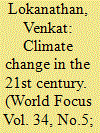

|
|
|
| 17 |
ID:
104983
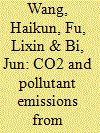

|
|
|
|
|
| Publication |
2011.
|
| Summary/Abstract |
In this paper, CO2 and pollutant emissions of PCs in China from 2000 to 2005 were calculated based on a literature review and measured data. The future trends of PC emissions were also projected under three scenarios to explore the reduction potential of possible policy measures. Estimated baseline emissions of CO, HC, NOx, PM10 and CO2 were respectively 3.16×106, 5.14×105, 3.56×105, 0.83×104 and 9.14×107 tons for China's PCs in 2005 with an uneven distribution among provinces. Under a no improvement (NI) scenario, PC emissions of CO, HC, NOx, PM10 and CO2 in 2020 are respectively estimated to be 4.5, 2.5, 2.5, 7.9 and 8.0 times that of 2005. However, emissions other than CO2 from PCs are estimated to decrease nearly 70% by 2020 compared to NI scenario mainly due to technological improvement linked to the vehicle emissions standards under a recent policy (RP) scenario. Fuel economy (FE) enhancement and the penetration of advanced propulsion/fuel systems could be co-benefit measures to control CO2 and pollutant emissions for the mid and long terms. Significant variations were found in PC emission inventories between different studies primarily due to uncertainties in activity levels and/or emission factors (EF).
|
|
|
|
|
|
|
|
|
|
|
|
|
|
|
|
| 18 |
ID:
126613


|
|
|
|
|
| Publication |
2013.
|
| Summary/Abstract |
With the current focus of policy action on climate change mitigation, it is important to investigate possible negative side effects of climate change policies on air pollutants. A 34% increase in CO2 emissions from private cars in Ireland over the period 2000-2008 prompted a change in private car taxation in 2008 to incentivise the purchase of lower CO2 emitting cars. The impact has been successful and the measure has accelerated the dieselisation of the car fleet. This however, raises an important question, namely how does the dieselisation of the car fleet affect NOx emissions? This paper combines two models to address this question, a car stock model to generate activity data (future composition and activity of Ireland's car stock) and the COPERT model to quantify the NOx emissions generated in the period 2008-2020. Previous analysis shows that the CO2 taxation policy measure is anticipated to deliver a 7% reduction in private car related CO2 emissions in 2020 compared with a baseline pre-tax scenario. The results here show that NOx emissions decrease in all scenarios, but a lesser degree of reduction is achieved due to dieselisation, with NOx emissions in the post-tax scenario 28% higher than the pre-tax scenario in 2020.
|
|
|
|
|
|
|
|
|
|
|
|
|
|
|
|
| 19 |
ID:
162906
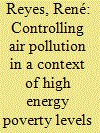

|
|
|
|
|
| Summary/Abstract |
Firewood is the main fuel used for heating in Chile, but its inefficient use is producing severe episodes of air pollution. To address this issue, authorities implement Air Pollution Management Plans (PDAs), which include actions such as setting moisture requirements for firewood, replacing old wood-stoves, temporarily banning the use of firewood, and improving homes´ thermal insulation. However, PDAs do not focus on nor do they prioritize measures in relation to specific social contexts. This study assessed socio-economic variables, energy consumption and indoor environments in households located in the city of Valdivia, through surveys and the monitoring of temperatures and indoor air pollution levels. We found that, during the winter months, 68% of the time living room temperatures were below 21 °C, and PM2.5 concentrations were above international standards. Furthermore, over 61% of households were to suffer a state of energy poverty. We urge decision-makers to consider social inequalities and energy consumption patterns in cities with high firewood consumption, prioritizing measures and focusing resources on reducing both air pollution and energy poverty. Thermal insulation of homes should be a priority in mid-to-low-income families, since these have the highest levels of energy demand. Other PDA´s measures could be economically regressive in these social-strata.
|
|
|
|
|
|
|
|
|
|
|
|
|
|
|
|
| 20 |
ID:
171427


|
|
|
|
|
| Summary/Abstract |
Mitigation strategies towards progressive decarbonization of the energy system are a valid approach to slow environmental pollution yielding social benefits, as established from National Energy and Climate Plan (NECP). The first objective is the increase of energy efficiency within 2030 by promoting the use of renewable energy and the electrification of consumption in other sectors (household and transport). Cost-benefit analysis (CBA) is an analytical tool to evaluate investments and support policy decisions for society's welfare. The paper aims to assess how CBA can be used to quantify the costs and related social benefits in different sectors (energy, transport and household) if the decarbonization scenario is applied in Italy in 2030. Overall, our findings show positive benefits obtained with the adoption of different mitigation strategies for all sectors. These results can provide significant support to decision-makers in the implementation of decarbonization scenario in Italy scheduled for 2030.
|
|
|
|
|
|
|
|
|
|
|
|
|
|
|
|
|
|
|
|
|